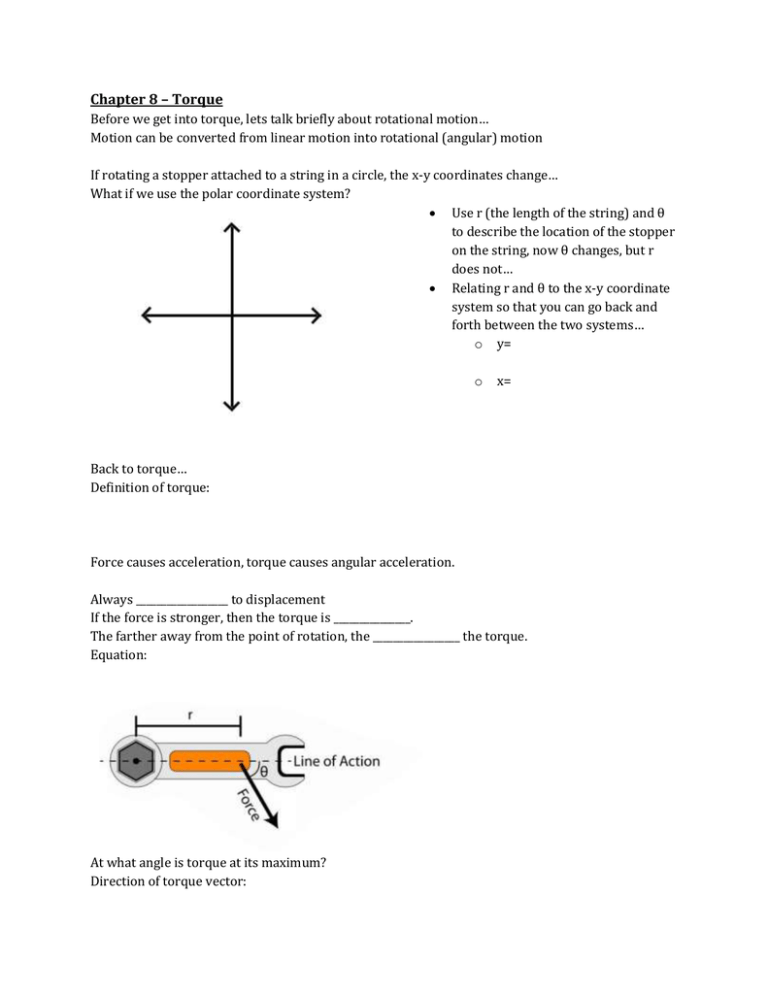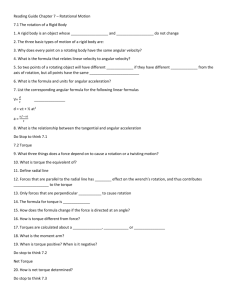Chapter 8 – Torque Before we get into torque, lets talk briefly about
advertisement

Chapter 8 – Torque Before we get into torque, lets talk briefly about rotational motion… Motion can be converted from linear motion into rotational (angular) motion If rotating a stopper attached to a string in a circle, the x-y coordinates change… What if we use the polar coordinate system? Use r (the length of the string) and θ to describe the location of the stopper on the string, now θ changes, but r does not… Relating r and θ to the x-y coordinate system so that you can go back and forth between the two systems… o y= o x= Back to torque… Definition of torque: Force causes acceleration, torque causes angular acceleration. Always __________________ to displacement If the force is stronger, then the torque is _______________. The farther away from the point of rotation, the _________________ the torque. Equation: At what angle is torque at its maximum? Direction of torque vector: Determined by the Right Hand Rule: + Torque = _____________________ rotation - Torque = _____________________ rotation Parallels between force and torque: Name Linear Variable Angular Variable Three types of Equilibrium: 1. Static: 2. Dynamic: 3. Rotational Ex1: A mechanic tightens the lugs on a tire by applying a torque of 100Nm at an angle of 90° to the line of action. What force is applied if the wrench is 0.4m long? How long must the wrench be if the mechanic is only capable of applying a force of 200N? Ex2: A 3Kg sign is hung from a 1 Kg horizontal pole as shown in the diagram. A wire is attached to prevent the sign from rotation. What is the tension in the wire? Ex3: A 10Kg object sits on a see-saw 1.0m from the fulcrum. Assume that the see-saw has no mass. Where must a second object sit in order to maintain static equilibrium? What is the force on the fulcrum? Ex4: A uniform meterstick of mass 0.20 kg is pivoted at the 40 cm mark. Where should one hang a mass of 0.50 kg to balance the stick? (A) 16 cm (B) 36 cm (C) 44 cm (D) 46 cm (E) 54 cm Ex5: The horizontal uniform rod shown above has length 0.60 m and mass 2.0 kg. The left end of the rod is attached to a vertical support by a frictionless hinge that allows the rod to swing up or down. The right end of the rod is supported by a cord that makes an angle of 30° with the rod. A spring scale of negligible mass measures the tension in the cord. A 0.50 kg block is also attached to the right end of the rod. (a) On the diagram below, draw and label vectors to represent all the forces acting on the rod. Show each force vector originating at its point of application. (b) Calculate the reading on the spring scale. (c) Calculate the magnitude of the force exerted by the hinge on the rod Name Torque Variable Units Equations





